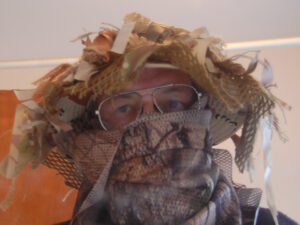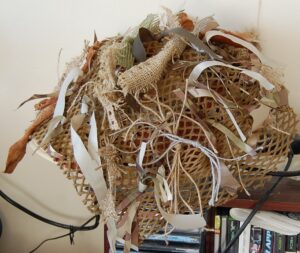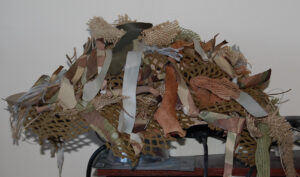Recently I have been working on a number of camouflage-related projects. There is a bit of an inherent problem with this. Good camouflage is difficult to photograph. Decades ago I was told: “If you want to know about camouflage, read a photography book about how to take good photographs then break the rules they give you!” You will understand this better in a moment.
Today’s project was an attempt to experiment with some ideas about headgear. If your helmet still looks like a helmet when its cover is fitted, it is not camouflage! Why are helmet nets designed to be flush with the helmet rim, I wondered. Good camouflage guides tell you to break up the regular shape of the rim. If the net hung down irregularly it would provide better camouflage. It might also keep some insects away and have other benefits. Done right, it would be easier to construct too.
My first problem is that I did not have a helmet. I decided to camouflage a boonie hat instead. I would construct the net in such a way that it could easily be transferred to a helmet or other headgear. I selected a hat with “chocolate chip” desert camouflage. I wanted whatever was beneath the net to be light for some negative space effect. There is also good contrast between the major elements of this pattern.
My second problem was trying to locate a suitable net within my very limited budget. I eventually hit on the idea of using a cheap string vest. I would have preferred a sand-yellow, beige or coyote-brown example but could only find khaki-drab. I suppose if you are making several you could dye some white vests. The holes are probably a bit small for some natural foliage, ¾ of an inch or 20mm being preferable.
Cut a piece of the vest in an irregular, roughly rectangular shape big enough to hang past the rim of your headgear. It should be short at the front but can be longer at the sides and back. Attachment is simple. The boonie hat already has a looped headband. Pass strings or tapes through these, through the net and tie with reef knots. For a helmet utilize the foliage bands of the issue helmet cover, or cut slots in the cover.
You now have a hat or helmet with a net draped over it. It is not camouflaged yet! One purpose of the net is to hold natural foliage, selected from what commonly grows in your area of operations. Light stuff is simply threaded through the net. Heavier stuff may need more support. This is often achieved by placing a rubber band around the helmet, beneath the net. This can be cut from a bicycle inner tube, surgical glove, elastic or similar materials.
Natural materials are supplemented by bits of cloth. For want of any better term we will call this “textilage”, since it is typically made from textiles and adds texture. Most of the materials used for this example were from a bag of off-cuts sold for the purpose. Be nice if more companies started doing this. Most of these bits are PU-nylon or condura in MTP camouflage. Some more variety and desert patterns would have been welcome, especially if the intention is to camouflage for sandy and urban environments. Other materials used include pieces of cut-up sandbag, medical gauze dyed with acrylic paint or tea, bits of cotton sock (also dyed) and jute string. Simply thread through the net and tie with an overhand knot. Shorter lengths that tend to stick up are used on the top of the hat, longer lengths that droop on the rest. Not that individual textilage bits do not need to be camouflaged. Anything in a suitable neutral or natural shade can be used.
You will end up with something that looks nothing like a hat or helmet, and that is what we are aiming for. Try your hat on and do some fine-tuning. You do not want anything within your visual arc that is obstructive or distracting. Pay attention to the peripheral areas of your vision.

OK, so what did my hat end up like? I only have one head available to model the hat, and it is not very photogenic. My attempt at a selfie was not really that successful, but it does show the distinctive brim shape of the hat is well disrupted.


A top view of the hat. The flash has revealed the pattern of the hat much more than it appears to the naked eye. I could have brought a cheaper, monochrome hat. The effect may be different if you have a lighter-coloured net or larger mesh.

Side view of the hat, very effectively hiding a chrome Phantasm ball.

Front view, no flash. Note how materials at the front hang past the brim less but still disrupt. If your helmet has an NVG mounting the net will hide it but can be raised so that it can be used.